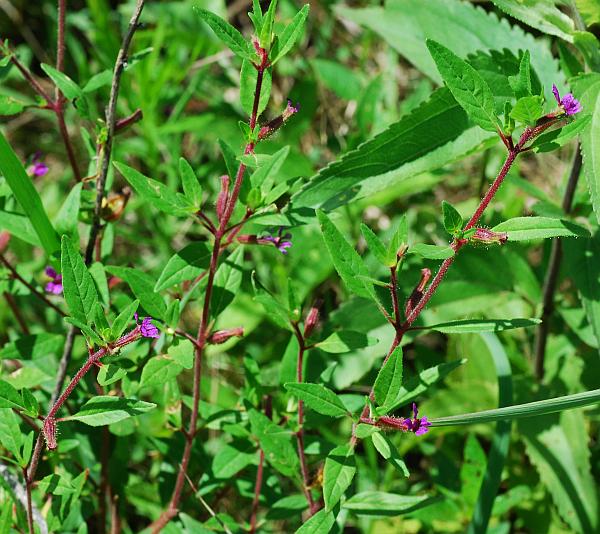Cuphea viscosissima Jacq.
Clammy Cuphea

Native
CC = 4
CW = 0
MOC = 66
© SRTurner
Cuphea viscosissima Jacq.Clammy Cuphea | |
 |
Native CC = 4 CW = 0 MOC = 66 |
© SRTurner |
|
Family - Lythraceae Stems - To +60cm tall, erect, herbaceous, branching, reddish-purple, dense simple and glandular pubescent, viscid, from branching taproot, single or multiple from base.
Leaves - Opposite, petiolate. Petioles to 1.3cm long, dense glandular and simple pubescent, reddish-purple above, greenish below. Blade lanceolate to lance-ovate, entire, acute, to 4.5cm long, -2cm broad, often slightly oblique at base, scabrous above, pubescent on midrib below nad sparse pubescent on rest of blade.
Inflorescence - 1-3 axillary flowers near apex of stems. Pedicels to 5mm long, dense pubescent (glandular and simple), with pair of minute opposite bracts at about the middle. Flowers - Petals 6, unequal, free, rose-purple, to 3.5mm long, suborbicular to obovate, drying to a deep blue-purple. Stamens 10 - 11, included, unequal, adnate at upper 1/4 of floral tube. Filaments pinkish, to 2mm long, with densely pilose(hairs white to pink). Style included, 3-4mm long, bifurcate at apex Ovary white, with thin papery exterior, 5mm long, glabrous. Placentation axile. Floral tube to 1.4cm long, densely glandular pubescent(hairs reddish-purple), 12-nerved, gibbous at base, 6-lobed. Lobes acute, to -1mm long. Upper-most lobe longer than others. Floral tube splitting in fruit and ovary deflexing. Seeds green, discoid, minute-tuberculate, 2.5-3mm in diameter.
Flowering - July - October. Habitat - Open woods, thickets, prairies, pastures, glades, roadsides. Origin - Native to the U.S. Other info. - This little species is common in the lower 2/3 of Missouri but is apparently absent from most of the northern portions of the state. The plant is easy to ID in the field because of its opposite leaves, purplish stems, and densely glandular, viscid floral tubes and stems. Photographs taken at Dave Rock Conservation Area, St. Claire County, MO., 7-27-00 and off CR 19-357, Shannon County, MO., 9-16-03 (DETenaglia); also at Whetstone Creek Conservation Area, 7-15-2016, and Cuivre River State Park, 9-29-2012 (SRTurner). |